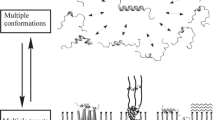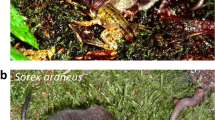Summary
This paper describes experiments designed to explore interactions between human red blood cell membranes and melittin, the main component of bee venom. We found that melittin binds to human red cell membranes suspended in isotonic NaCl at room temperature, with an apparent dissociation constant of 3×10−8 m and maximum binding capacity of 1.8×107 molecules/cell. When about 1% of the melittin binding sites are occupied, cell lysis can be observed, and progressive, further increases in the fraction of the total sites occupied lead to progressively greater lysis in a graded manner. 50% lysis occurs when there are about 2×106 molecules bound to the cell membrane. For any particular extent of melittin binding, lysis proceeds rapidly during the first few minutes but then slows and stops so that no further lysis occurs after one hour of exposure of cells to melittin. The graded lysis of erythrocytes by melittin is due to complete lysis of some of the cells, since both the density and the hemoglobin content of surviving, intact cells in a suspension that has undergone graded melittin lysis are similar to the values observed in the same cells prior to the addition of melittin. The cells surviving graded melittin lysis have an increased Na and reduced K, proportional to the extent of occupation of the melittin binding sites. Like lysis, Na accumulation and K loss proceed rapidly during the first few minutes of exposure to melittin but then stops so that Na, K and hemoglobin content of the cells remain constant after the first hour. These kinetic characteristics of both lysis and cation movements suggest that melittin modifies the permeability of the red cell membrane only for the first few minutes after the start of the interaction. Direct observation of cells by Nomarsky optics revealed that they crenate, become swollen and lyse within 10 to 30 sec after these changes in morphology are first seen. Taken together, these results are consistent with the idea that melittin produces lysis of human red cells at room temperature by a colloid osmotic mechanism.
Similar content being viewed by others
References
Bjerrum, P.J. 1979. Hemoglobin-depleted human erythrocyte ghosts: Characterization of morphology and transport functions.J. Membrane Biol. 48:43–67
Bowdler, A.J., Williams, R.H., Dougherty, R.M. 1984. Abrogation of calcium exclusion by erythrocytes under hypotonic stress.Scand. J. Haematol. 32:283–296
Brown, L.R., Lauterwein, J., Wüthrich, K. 1980. High resolution1H-NMR studies of self-aggregation of melittin in aqueous solution.Biochim. Biophys. Acta 622:231–244
Dannon, D., Marikovsky, Y. 1964. Determination of density distribution of red cell population.J. Lab. Clin. Med. 64:668–674
Davies, J.T., Rideal, E.K. 1963. Interfacial Phenomena. 2nd ed. Academic, New York and London
Dawson, C.R., Drake, A.F., Helliwell, J., Hider, R.C. 1978. The interaction of bee melittin with lipid bilayer membranes.Biochim. Biophys. Acta 510:75–86
DeGrado, W.F., Musso, G.F., Lieber, M., Kaiser, E.T., Kezdy, F.J. 1982. Kinetics and mechanism of hemolysis induced by melittin and by a synthetic melittin analogue.Biophys. J. 37:329–338
Dufourcq, J., Faucon, J.F. 1977. Intrinsic fluorescence study of lipid-protein interaction in membrane models. Binding of melittin, an amphipathic peptide, to phospholipid vesicles.Biochim. Biophys. Acta 467:1–11
Funder, J., Tosteson, D.C., Wieth, J.O. 1978. Effects of bicarbonate on lithium transport in human red cells.J. Gen. Physiol. 71:721–746
Habermann, E. 1972. Bee and wasp venoms.Science 177:314–322
Habermann, E., Ahnert-Hilger, G., Chatwal, G.S., Beress, L. 1981. Delayed hemolytic action of palytoxin. General charactertics.Biochim. Biophys. Acta 649:481–489
Hanke, W., C. Methfessel, C., Wilmesen, H.-U., Katz, E., Jung, G., Boheim, G. 1983. Mellitin and a chemically modified trichotoxin form alamethicin-type multi-state pores.Biochim. Biophys. Acta 727:108–114
Kemp, C., Klausner, R.D., Weinstein, J.N., Renswoude, J., van, Pincus, M., Blumenthal, R. 1982. Voltage-dependent trans-bilayer orientation of melittin.J. Biol. Chem. 257:2469–2476
Maulet, Y., Cox, J.A. 1983. Structural changes in melittin and calmodulin upon complex formation and their modulation by calcium.Biochemistry 22:5680–5686
Podo, F., Strom, R., Crifo, C., Zulauf, M. 1982. Dependence of melittin structure on its interaction with multivalent anions and with model membrane systems.Int. J. Peptide Protein Res. 19:514–527
Quay, S.C., Condie, C.C. 1983. Conformational studies of aqueous melittin: Thermodynamic parameters of the monomer-tetramer self association reaction.Biochemistry 22:695–700
Schoch, P., Sargent, D.F. 1980. Quantitative analysis of the binding of melittin to planar lipid bilayers allowing for the discrete-charge effect.Biochim. Biophys. Acta 602:234–247
Schröder, E., Lübke, K., Lehmann, M., Beetz, I. 1971. Hemolytic activity and action on the surface tension of aqueous solutions of synthetic melittins and their derivatives.Experientia 27:764–765
Sessa, G., Freer, J.H., Colacicco, G., Weismann, G. 1969. Interaction of a lytic peptide, melittin, with lipid membrane systems.J. Biol. Chem. 244:3575–3582
Sheetz, M.P., Singer, S.J. 1974. Biological membranes as bilayer couples. A molecular mechanism of drug-erythrocyte interactions.Proc. Natl. Acad. Sci. USA 71:4457–4461
Stankowski, S. 1983. Large-ligand adsorption to membranes. I. Linear ligands as a limiting case.Biochim. Biophys. Acta 735:341–351
Terwillinger, T.C., Weissman, L., Eisenberg, D. 1982. The structure of melittin in the form I crystals and its implication for melittin's lytic and surface activities.Biophys. J. 37:353–361
Tosteson, D.C. 1967. Electrolyte composition and transport in red blood cells.Fed. Proc. 26:1805–1812
Tosteson, M.T., Tosteson, D.C. 1981. The sting: Melittin forms channels in lipid bilayers.Biophys. J. 36:109–116
Tosteson, M.T., Tosteson, D.C. 1984. Activation and inactivation of melittin channels.Biophys. J. 45:112–114
Wilbrandt, W. 1941. Osmotische Natur sogenaunter nichtosmotischer Hämolysen (Kolloidosmotische Hämolyse).Pfluegers. Arch. Gesamte Physiol. 245:22
Author information
Authors and Affiliations
Rights and permissions
About this article
Cite this article
Tosteson, M.T., Holmes, S.J., Razin, M. et al. Melittin lysis of red cells. J. Membrain Biol. 87, 35–44 (1985). https://doi.org/10.1007/BF01870697
Received:
Issue Date:
DOI: https://doi.org/10.1007/BF01870697




